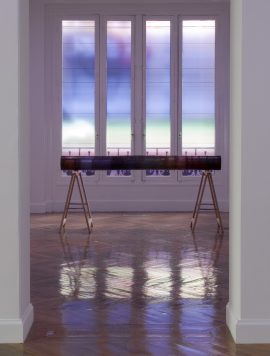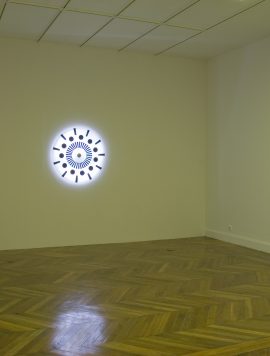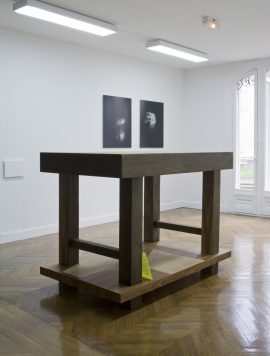Bettina Samson
For her first major solo exhibition, Bettina Samson has devised a specific project: fusing her recent experiments inspired by scientific discoveries and her interest in the history of utopias. Combining these two lines of research with an investigation of the technical and social implications of progress, about fifteen artworks – most of them created especially for the exhibition – play with our perception, transforming La Galerie into a landscape of temporal strata.
Viewed from the entrance, the exhibition seems like a succession of complementary, atmospherically-coloured spaces, which host sets of works on the ground and basement floors. In the exhibition design light is used to suggest states of perception related to historical or geographical situations; it has a direct presence as a “revealer” of images, particularly in the film and the photographs obtained by default from radiation emitted by a stone containing uranium. The exhibition is underpinned as much by the act of seeing as by the depiction of invisibility.1
What characterises Bettina Samson’s work, more than its variety (installation, sculpture, photography, video…), is the heterogeneous quality of its forms. In this deliberately mixed bag, the forms, techniques and materials chosen by the artist match the distinctive character of each exploration. These works, besides their various stylistic affiliations with moments in art history, share a hybrid craftsmanship, somewhere between nonscale models and distorted reconstructions (Becquerel’s workbench). Handmade or technically imperfect, they seem to embody the share of errors in the experiments that the artist here re-performs, using incomplete documents and partial sources.
Her references – from the first photograph of the solar spectrum in 1848 to the discovery in 1896 of the radioactive properties of uranium, to Einstein’s nuclear recommendations in 1939; from the existence of a socialist community in the Mojave Desert in 1914-1917 to Aldous Huxley’s psychedelic experiment in the same desert in the 1950s – intersect and sometimes overlay each other, verging on anachronism. Each of these seemingly unrelated topics embodies a historical turning-point in the looming shadow of dystopia. Time collides in each work but also on exhibition-scale – and, in the film 5 fois 3:30 d’expositions (“Exhibitions / Exposures: 5 times 3’ 30”), like a stratum even older than the exhibition. Time actually becomes the subject of certain works, particularly the core bore sample of the solar spectrum and the stroboscopic disc that turns backward while referencing Huxley’s short story Tomorrow and Tomorrow and Tomorrow.
While accurately outlining the forms liable to condense her investigations, Bettina Samson produces series of works whose references become entangled between exhibitions. One re-encounters, in the form
of yellow filters, the evocation of the Mojave Desert already present at the Palais de Tokyo,2 enriched here by new stories: that of the utopian community Llano del Rio in the early 20th century and the one about the near-blindness of Huxley, who lived there in the 1960s. Likewise, having completed their tour of the exhibition, visitors will make a connection between the Becquerels, father and son physicists brought together by the practice of “blind” photography, poised between scientific means and artistic end. The artist pushes this method of construction and deconstruction as far as the entropic mise en abyme of her own works: screened in La Galerie’s basement, the film of an earlier exhibition3 filmed five times and then lengthily exposed to the radiation of a slightly radioactive stone, closes the loop.
Marianne Lanavère
Translated by Paul Jones
1. Bettina Samson’s explorations clearly resonate with certain issues previously addressed in La Galerie’s programming, from rendering invisibility (Dominique Blais and Spencer Finch in “Night Visions”, 2008) to reactivating the hidden dimension of scientific experiments (Christian Frosi, Gusmão & Paiva and Nick Laessing, in Simone Menegoi’s exhibition “Tales of Disbelief”, 2008; as well as in Clément Chéroux’s associated lecture), and the links between perception and utopia (A Contemporary City by Evariste Richer, 2007, and After Nancy (The Model) by Bertrand Lamarche, 2008).
2. Bettina Samson’s exhibition “Replica”, Module 1, Palais de Tokyo, Paris, 2009.
3. Bettina Samson and Julien Tiberi’s exhibition “Stratos Fear”, RLBQ, Marseille, 2008.
around the exhibition
-
14/01/2010
From 7:00 to 9:00 pm
“A time for art”: art criticism workshop open to all with Laurence Corbel, Sally Bonn and Anne Bonnin (art critic invited).
In partnership with the University of Paris I Centre for the Philosophy of Art. -
24/01/2010
From 7:00 to 9:00 pm
“A time for art”: art criticism workshop open to all with Laurence Corbel, Sally Bonn and Anne Bonnin (art critic invited).
In partnership with the University of Paris I Centre for the Philosophy of Art. -
13/02/2010
From 6:30 to 9:00 pm
Closing evening: Encounter with Bettina Samson and Marianne Lanavère, and performances by Roxane Borujerdi, artist.




